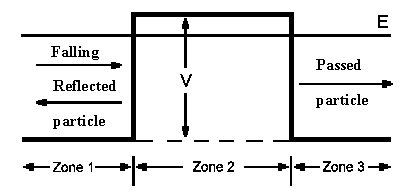Let's consider a particle with mass m which is moving with energy E (from left side) up to potential barrier having width a:

| Zone 1 | Zone 2 | Zone 3 |
| y1 = A1eik1x + B1e−ik1x k12
= 2m E/ |
y2 = A2 eik2x + B2 e−ik2x k22
= 2m (E−V)/ |
y3 = A3 eik3x + B3 e−ik3x k32
= k12 = 2m E/ |
If the particle energy E is smaller than V in zone 2: k22< 0, i.e. k2 is imaginary number. If we write down k2 = ik where k is real number now k2= 2m (V−E)/h² then we will obtain the
following wavefunction in zone 2:
y2 = A2 e−kx + B2 ekx
This function doesn't vibrate but shows the exponential dependence on x.
Now we will calculate coefficients Ai and Bi (i = 1, 2,
3). Since particles come from the left side the coefficient B3 should be
0 because the wavefunction B3 e−ik1x
corresponds to particles moving from right to the left. However there are no
such particles ! The coefficient B1 should not be 0 since particles
can be reflected by potential barrier and then move back to the left. Another
coefficients can be obtained from boundary conditions and normalization: y and y' should be continuous
| x = 0 | x = a | |
| y continuous: | A1 + B1 = A2 + B2 | A2 e−ka + B2 eka = A3 eik1a |
| y' continuous: | ik1A1 − ik1B1 = −kA2 + kB2 | -kA2 e−ka + kB2 eka = ik1A3 eik1a |
The coefficient B1 determines the probability
(|B1|2) for the particle to be reflected and the
coefficient A3 corresponds to the probability
(|A3|2) for the particle to pass through potential barrier
V and then move along the right side with hk. The
transmission probability T = |A3|2/|A1|2 corresponds to the chance for
particle to cross a barrier. Simple but detailed transformations of the
above-mentioned boundary conditions give finally:
| T = {1 + [eka−
e−ka]2/[16 E/V (1-E/V)]}-1
where k = (2m(V-E)/ or T = {1 + sinh2(ka)/[4 E/V (1-E/V)]}-1 |
Although E < V the transmission probability T isn't equal to 0, i.e. a
particle can cross the potential barrier that isn't allowed in classical
physics.
The wavefunction isn't equal to 0 at point x=0 since V is finite in
height and width. One can write down the following approximation for ka >
1:
| T ≈ 16 E/V (1 − E/V) e−2ka |

| T = [1 - sin²
k' a/4 E/V (1 −
E/V)]-1
where k' = (2m(E-V)/ |
|
T = [1 −ma²V/2 |
![]()
Auf diesem Webangebot gilt die Datenschutzerklärung der TU Braunschweig mit Ausnahme der Abschnitte VI, VII und VIII.